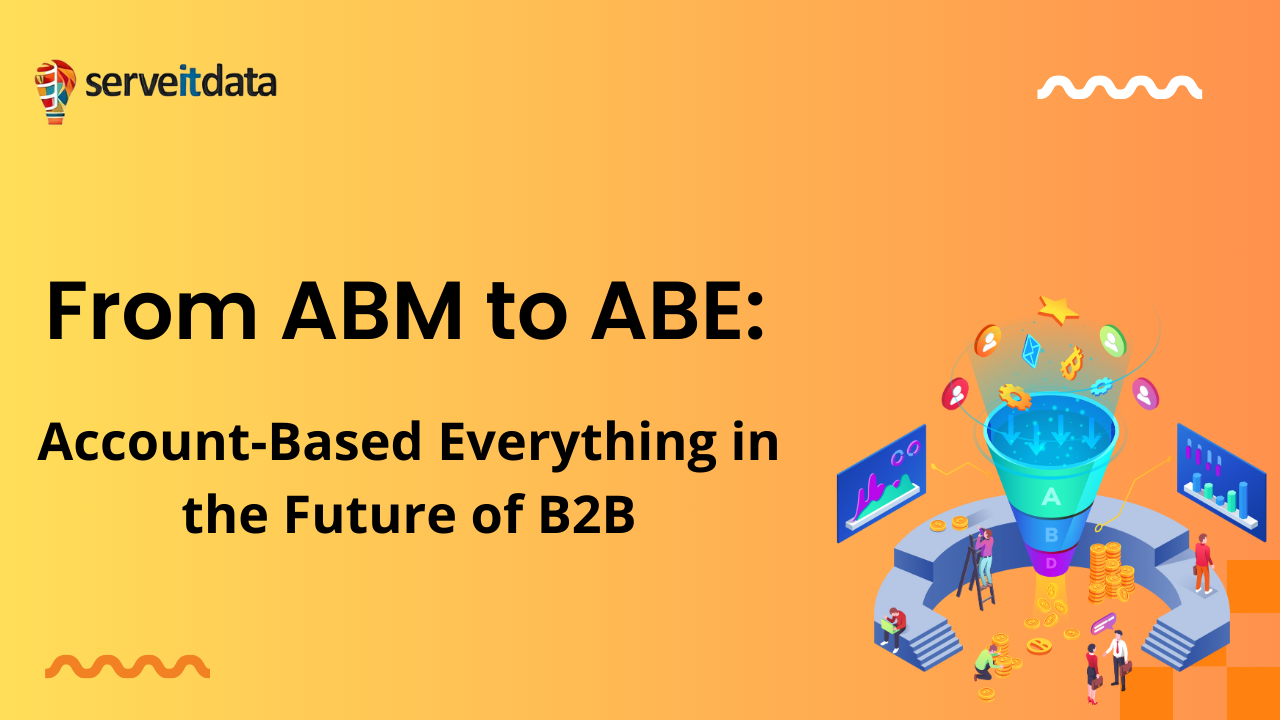From ABM to ABE: Account-Based Everything in the Future of B2B
In the ever-evolving landscape of B2B marketing, staying ahead of the curve is crucial for success. Over the years, the approach to targeting high-value accounts has transformed from Account-Based Marketing (ABM) to what is now known as Account-Based Everything (ABE). As a senior B2B content writer at ServeIT Data, with previous experience at Forrester, I’ll delve into the shift from ABM to ABE and the implications it carries for the future of B2B marketing.
The Genesis of ABM: A Recap
Account-Based Marketing, or ABM, is a strategy that focuses on targeting high-value accounts with highly personalized marketing campaigns. Instead of casting a wide net to capture as many leads as possible, ABM is about precision and efficiency. It identifies key accounts that align with a business’s ideal customer profile and tailors marketing efforts to engage and convert these accounts into loyal customers.
The Limitations of ABM
ABM has proven highly effective, but it’s not without its limitations. Here are a few key challenges that have paved the way for the evolution to ABE:
1. Narrow Focus: ABM typically revolves around marketing and sales alignment for a few select accounts. While it’s excellent for specific campaigns, it doesn’t account for the broader context of the customer journey.
2. Lack of Holistic Approach: ABM tends to emphasize marketing activities at the top of the funnel. It may not address post-purchase nurturing or customer retention, leaving gaps in the customer experience.
3. Limited Data Integration: ABM often uses separate tools and systems for marketing and sales efforts, leading to data silos and inefficiencies.
The Birth of ABE
Account-Based Everything, or ABE, represents a broader approach that transcends the boundaries of ABM. It acknowledges that high-value accounts deserve comprehensive attention throughout the customer journey. ABE expands the scope of ABM by considering marketing, sales, and customer success in an integrated, account-centric strategy.
Key Components of ABE
ABE encompasses the entire customer lifecycle, taking a more holistic view of engaging and retaining high-value accounts:
1. Marketing: ABE retains the core principles of ABM—precision targeting, personalized messaging, and tailored campaigns. However, it extends these practices throughout the customer journey, from awareness to advocacy.
2. Sales: Sales teams are heavily involved in ABE, not just for closing deals but for continuous account engagement. They work alongside marketing to maintain personalized communications.
3. Customer Success: ABE emphasizes post-sale account management. It involves customer success teams to ensure that the experience remains tailored and valuable even after the initial purchase.
The Implications of ABE for B2B Marketing
The shift from ABM to ABE carries several implications for the future of B2B marketing:
1. Enhanced Customer Experience: ABE’s customer-centric approach ensures that high-value accounts receive a consistent, personalized experience throughout their journey. This fosters loyalty and advocacy.
2. Data Integration: ABE demands integrated data systems that allow marketing, sales, and customer success teams to collaborate effectively. This integration ensures a seamless flow of information, ultimately benefiting the customer.
3. Sales and Marketing Alignment: ABE necessitates a tighter alignment between sales and marketing teams. Both functions work in tandem, understanding each other’s strategies and objectives.
4. Lifecycle Marketing: With ABE, the focus shifts from one-off campaigns to continuous lifecycle marketing. This approach requires a more extensive content and communication strategy that caters to different stages of the customer journey.
5. Technology Investment: To implement ABE successfully, B2B companies need to invest in technology that enables data integration, personalized communication, and comprehensive account management.
Case Study: The ABE Success Story
Consider a B2B software company that transitioned from ABM to ABE. By integrating its marketing, sales, and customer success teams, the company achieved impressive results. High-value accounts now receive personalized communication from the awareness stage all the way through their lifecycle. The customer success team ensures that these accounts continue to receive value from their purchase, leading to increased customer retention and advocacy.
In Conclusion, The shift from ABM to ABE represents an evolution in B2B marketing that addresses the limitations of the former by taking a holistic, customer-centric approach. ABE recognizes that high-value accounts deserve continuous personalized engagement, not just at the acquisition stage but throughout their journey. By fostering alignment between marketing, sales, and customer success and investing in integrated technology, businesses can unlock the full potential of ABE, leading to enhanced customer experiences and long-term success in the world of B2B marketing.


